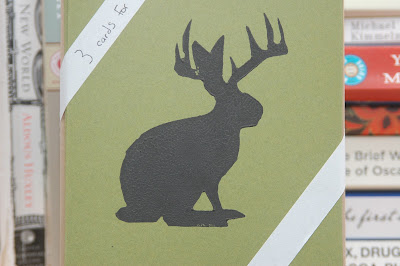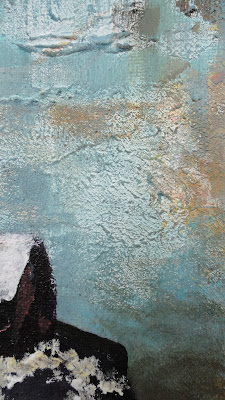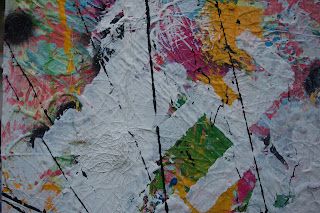Animals are so clever - the technology that we are creating could potentially be used to create art with other species! OK, maybe a long shot, but it would be an interesting art show... I wonder what would happen if you gave the ipad to a chimp?
Saturday, December 11, 2010
Monday, December 6, 2010
Wednesday, December 1, 2010
Deaths - head hawk moth
Last week I was in Michigan visiting my family for Thanksgiving. After rumaging through some old binders of mine, I found an anatomically correct drawing of a deaths-head hawk moth (http://en.wikipedia.org/wiki/Death%27s-head_Hawkmoth). I love it and think I may turn it into a print...
Case-Control Geographic Clustering for Mobile Populations: Methods for Infectious and Chronic Diseases
Several years ago, my Dad and I wrote a paper on the best way to study infectious and chronic diseases. Because people live in different locations during their life and spend a large portion of their life at work, spatial and residential histories must be gathered and implemented in time based software. The case for this type of methodology is made by illustrating its effectiveness with a bladder cancer study conducted in South East Michigan. Not only did I get to help write this paper, I got to collect water samples from the case and controls homes and work (2 samples, one frozen and one not), urine samples and toenail samples. Thankfully, I did not have to work with the samples in the lab, but reaped the benefits. Our paper can now we be found online (abstract below)!
http://www.geocomputation.org/
Abstract
Humans are mobile and constructs of Geographic Information Science have been used
to model daily and weekly activity patterns, as well as residential and work spaces. But
geographic epidemiology often ignores human mobility and employs methods that
assume humans are sessile rather than mobile. This paper first quantifies how relaxing
the assumption of sessile individuals might impact case-control cluster tests, and finds
the results are highly sensitive to when the system is observed. Recently developed
tests for case-control clustering that account for human mobility are then presented,
along with extensions to the analysis of infectious disease data. We conclude by
revisiting an analysis of bladder cancer in south eastern Michigan, and demonstrate the
ability of the new techniques to detect global and local clustering in case-control data
for residential histories. Statistical techniques that account for human mobility are
needed for chronic and infectious diseases where causative exposures occur at
locations different from ones location at time of diagnosis.
Friday, November 5, 2010
Oil? Acrylic? Abstract? Realistic?
One fish! Two fish! Red fish! Blue fish!
I am constantly influenced by the world around me and have a tendency to imitate other artists work or style. Most of the work I love is abstract, and as a result, my work ends up abstract. At some point, I was almost unsure if I knew how to represent the real world anymore! After flipping through a photo journal, I found a series of beautiful painterly images of dilapidated buildings and rooms and decided I needed to try something new. A painting is abstract in its own right: what you are looking at certainly is not two chairs in disrepair but rather an image (digital files) of an image (painting) of an image (photo) of two chairs. Who knows what they really look like?
After painting, someone pointed out how they looked similar to an oil painting, even though I am working in arcylic. Unfortunately, these images do not give the texture justice, but I used a specific textured paint that crackles after a few hours to give texture to the wall and to provide body to the yellowing chair stuffing. The result mimics the broken visual texture seen in the original image.
I am constantly influenced by the world around me and have a tendency to imitate other artists work or style. Most of the work I love is abstract, and as a result, my work ends up abstract. At some point, I was almost unsure if I knew how to represent the real world anymore! After flipping through a photo journal, I found a series of beautiful painterly images of dilapidated buildings and rooms and decided I needed to try something new. A painting is abstract in its own right: what you are looking at certainly is not two chairs in disrepair but rather an image (digital files) of an image (painting) of an image (photo) of two chairs. Who knows what they really look like?
After painting, someone pointed out how they looked similar to an oil painting, even though I am working in arcylic. Unfortunately, these images do not give the texture justice, but I used a specific textured paint that crackles after a few hours to give texture to the wall and to provide body to the yellowing chair stuffing. The result mimics the broken visual texture seen in the original image.
Wednesday, November 3, 2010
Halloween costumes 2010
This year, on a business trip 5 days before Halloween, I began thinking about what I should dress up as. I remember years ago when I planned months, literally months, in advance to ensure I had the best costume I could come up with. In college, naturally, I wanted to fit in and dress in a sexy little store bought costume. Truth be told, the purchased outfits were 1.) overpriced and 2.) made me feel more uncomfortable than ever.
This year, I decided to ditch the same generic outfits offered nation wide and went for something practical, creative and easily recognizable. Its also way more fun to do a costume with a partner in crime or with a group. I recruited my boyfriend, two bubble umbrellas ordered from Amazon.com (remember, I am on a business trip and had little time to shop), translucent gift wrap from Michael's and bubble wrap generously donated from work. Oh and don't forget the tape (did I mention it was no-sew?)! Thursday night, I sat down, attached strips of bubble wrap to the tips of the umbrellas and hung thoughtfully cut pieces of gift wrap to the metal architecture. The result? An admittedly fragile, but beautiful guise.
Key to our outfits was color coordination... I utilized mainly purple items and wore a purple shirt whereas my boyfriend used the blue gift wrap and donned a baby blue American Apparel tee. The gold lame pants really finished the look.
This year, I decided to ditch the same generic outfits offered nation wide and went for something practical, creative and easily recognizable. Its also way more fun to do a costume with a partner in crime or with a group. I recruited my boyfriend, two bubble umbrellas ordered from Amazon.com (remember, I am on a business trip and had little time to shop), translucent gift wrap from Michael's and bubble wrap generously donated from work. Oh and don't forget the tape (did I mention it was no-sew?)! Thursday night, I sat down, attached strips of bubble wrap to the tips of the umbrellas and hung thoughtfully cut pieces of gift wrap to the metal architecture. The result? An admittedly fragile, but beautiful guise.
Key to our outfits was color coordination... I utilized mainly purple items and wore a purple shirt whereas my boyfriend used the blue gift wrap and donned a baby blue American Apparel tee. The gold lame pants really finished the look.
Saturday, October 30, 2010
Congrats Beili!
In college, I took a class with Beili Liu. She was, and still is one of my favorite artists. Her class was one of my favorites and redefined the way I thought about art. See the video below, she won a 50K artists grant!
Sunday, September 12, 2010
Untitled
The naming of a piece is by far one of the most difficult tasks I have encountered as an artist. The title can bring a moment of revelation to the viewer, or it can convolute its meaning. Earlier today I installed one of my first large scale paintings in a clients home and he asked me what I had named it. Sometimes, it takes me months to name a painting and sometimes all I need is a dictionary. Currently, it remains untitled but is influenced by meteorology, the bus lines in San Francisco, graffiti street art, fault lines, electrical wires, a spa in Whistler, energy and the urban sky line. Free association writing or dream interpretation is certainly in my future.
The medium wars: Photography vs. painting
As I mentioned before, Christmas in Aspen was a copy of a photograph. For a period of time I was fascinated by making images that looked like a Rothko, Pollock or other abstract pieces. Photography and painting have for so long been considered vastly different mediums; it is wonderful to see the two intertwine. One of the arguments made against abstract art is that it does not look nearly as challenging to make as a landscape. I would argue that a landscape image is easier because the artists knows exactly what they are going to make. There is a distinct finish and an end. An abstract piece has no definitive ending. By taking long exposure images of lights, I can create an image to work from in turn easing the creation of abstract paintings.
Two artists, a photographer and a painter, whose work have influenced each other are Steve Coron and Karie Wagner. Karie and Steve have developed their artistic skills and visual taste together. The result is a symbiosis: Steve take landscape photos that Karie paints from, and Steves images end up achieving a painterly look and feel. The first two images below are Steves, the third is Karie's.
Two artists, a photographer and a painter, whose work have influenced each other are Steve Coron and Karie Wagner. Karie and Steve have developed their artistic skills and visual taste together. The result is a symbiosis: Steve take landscape photos that Karie paints from, and Steves images end up achieving a painterly look and feel. The first two images below are Steves, the third is Karie's.
Saturday, September 4, 2010
Christmas in Aspen
What you are looking at is a painting of a photo that is meant to look like a painting.


Form meets function
Q.) What do you do when you have lemons?
A.) Make lemon aide!
Q.) What do you do when you are in British Columbia with an excess of invasive lodge pole pine trees?
A.) Make coasters!
A.) Make lemon aide!
Q.) What do you do when you are in British Columbia with an excess of invasive lodge pole pine trees?
A.) Make coasters!
Round & round we go!
Not only a birthday present, but also a test. These paintings, 4" x 4", began as an experiment. By working small, I can experiment and achieve results more quickly than working on a bigger canvas. These learnings on technique, the acrylic medium and style can, and will be applied to larger pieces.
Saturday, August 21, 2010
Thursday, August 19, 2010
Tuesday, August 17, 2010
Plastic progress
I began working on this project 8 months ago, shorty after the new year. It began as a commissioned piece for a friend of mine; the painting was to be influenced by Julie Mehretu, maps, weather patterns and fault lines. I cannot pin point exactly where my inspiration came from, but the canvas has had many faces since January. The inspiration began here (research), went here (where I began setting the textural foundation), then here:
and is now near an ending point, seen below. The process entailed painting layers over layers over layers, reclaiming lines and marks, then making more layers. Much of the texture cannot be seen or appreciated in the photos.
Here is some inspiration for my next piece:
and is now near an ending point, seen below. The process entailed painting layers over layers over layers, reclaiming lines and marks, then making more layers. Much of the texture cannot be seen or appreciated in the photos.
Here is some inspiration for my next piece:
Subscribe to:
Posts (Atom)


























































